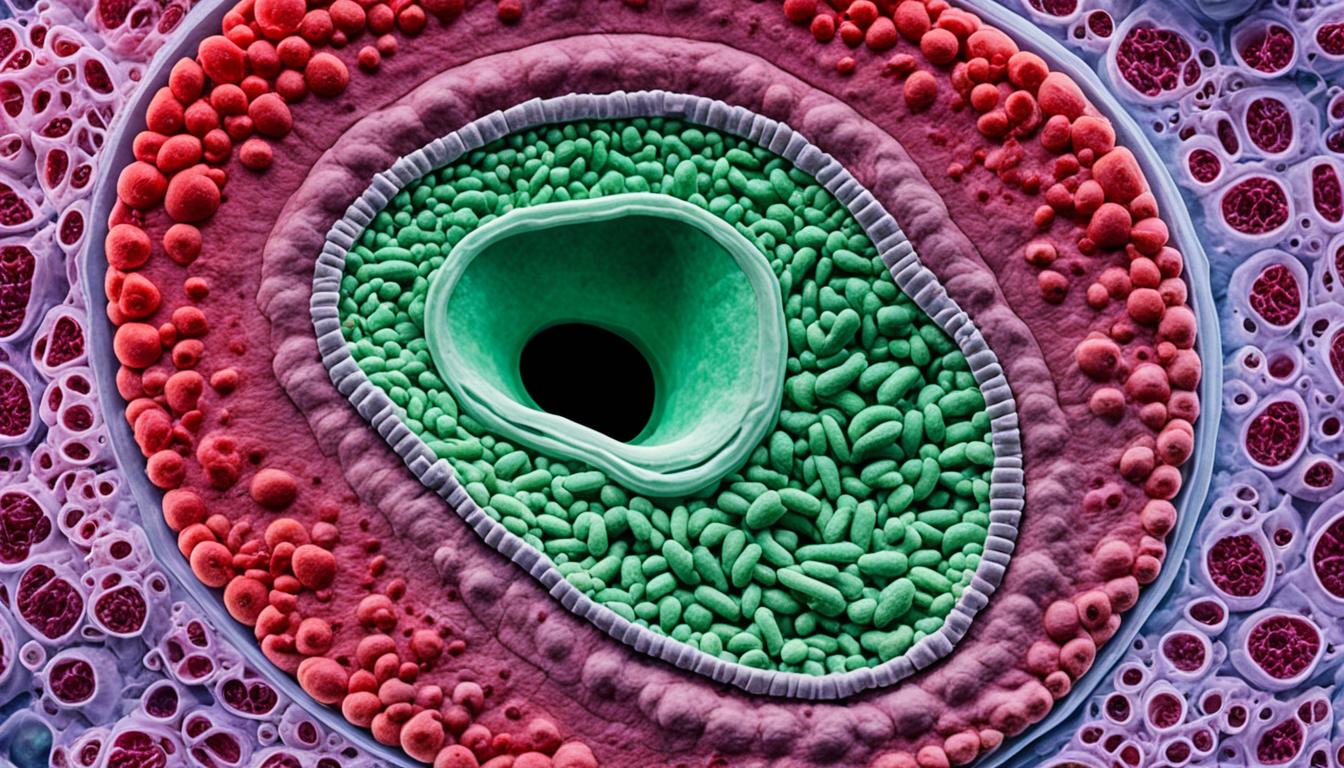Cholecystitis is a type of disease where the gallbladder gets inflamed. There are two main types: acute and chronic. Acute cholecystitis is often caused by gallstones blocking bile flow. This leads to pain in the abdomen, fever, and pain in the upper right side of the body.
Chronic cholecystitis happens when the gallbladder is inflamed for a long time. It’s usually because of gallstones or other health issues. If not treated, both types can cause severe problems like a gallbladder infection or even the tissue dying.
Key Takeaways:
- Cholecystitis means the gallbladder is inflamed.
- Gallstones usually cause acute cholecystitis, bringing symptoms such as stomach pain, fever, and upper right stomach pain.
- Chronic cholecystitis comes from ongoing gallbladder inflammation, often due to gallstones or other conditions.
- If left alone, acute and chronic cholecystitis can lead to dangerous issues.
- Doctors find and treat cholecystitis using exams, tests, and imaging.
Types and Symptoms of Cholecystitis
Cholecystitis comes in two types: acute and chronic. Acute cholecystitis happens fast, often because of gallstones. These stones block a duct, causing the gallbladder to get inflamed. It brings a mix of symptoms.
The main sign is pain in the stomach area. People feel this pain as sharp or like a cramp. It’s mainly in the upper right side. The ache might also spread to the back or right shoulder. Important to know, not everyone feels the same amount of pain. For some, it’s just mild, for others, it’s severe.
Along with stomach pain, you might feel sick, throw up, and get gassy. These can happen if you just had a big, fatty meal. Many people with cholecystitis don’t feel like eating. The symptoms are too uncomfortable.
Having a fever is another sign you might have cholecystitis. An inflamed gallbladder can also mean an infection. Fever, chills, and sweating often come together.
If these symptoms sound familiar, see a doctor. Early treatment can lessen symptoms and stop things from getting worse.
Diagnosis and Treatment of Cholecystitis
Diagnosing cholecystitis involves a physical exam and tests. A doctor looks for signs of gallbladder inflammation. They do this after asking about your symptoms.
Ultrasound is often used to find gallstones. This test checks the gallbladder’s health. Blood tests add more details, like white blood cell count and liver function.
If cholecystitis is hard to diagnose, CT or MRI scans may be done. These give a more detailed look at the gallbladder.
The treatment for cholecystitis depends on how severe it is. Acute cases might need antibiotics and fasting. Intravenous fluids are given to keep healthy. Sometimes, surgery to remove the gallbladder is needed.
Science is also looking at using stem cells in cholecystitis treatment. This new area aims to heal the gallbladder without surgery. But, more studies are required to confirm its benefits and safety.
FAQ
Q: What is cholecystitis?
A: Cholecystitis is when the gallbladder gets inflamed, causing a lot of pain.
Q: What are the different types of cholecystitis?
A: There are two kinds: acute, which comes suddenly, and chronic, which lasts a long time.
Q: What causes acute cholecystitis?
A: Acute cholecystitis happens when gallstones block the bile flow, and bile gets stuck in the gallbladder.
Q: What are the symptoms of cholecystitis?
A: Signs include stomach ache, fever, and pain in the upper right side of the abdomen.
Q: What are the symptoms of acute cholecystitis?
A: You might feel stomach ache, have a fever, and notice pain in the right upper abdomen. Nausea, vomiting, and not feeling hungry are also signs.
Q: What are the symptoms of chronic cholecystitis?
A: Chronic cholecystitis causes ongoing stomach pain, fever, and pain in the upper right abdomen. You may also have other long-term body inflammation.
Q: What complications can occur if cholecystitis is left untreated?
A: Not treating cholecystitis can lead to a dangerous gallbladder infection, death of gallbladder tissue, or the gallbladder bursting.
Q: How is cholecystitis diagnosed?
A: Doctors will check symptoms, do blood tests, and look at imaging like ultrasounds to diagnose cholecystitis.
Q: What imaging tests are used to diagnose cholecystitis?
A: Ultrasounds find gallstones and show the gallbladder’s state. If needed, CT or MRI scans give more detailed images.
Q: Are blood tests done to diagnose cholecystitis?
A: Yes, blood tests look for signs like high white blood cells and liver issues to help diagnose cholecystitis.
Q: How is cholecystitis treated?
A: Cholecystitis is treated with removing the gallbladder, using antibiotics, fasting, and getting fluids through a vein. Stem cell therapy is sometimes an option.

